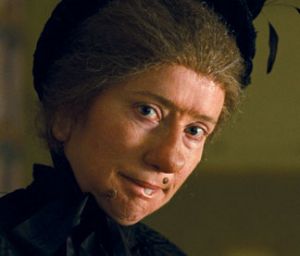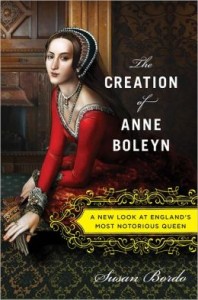
Thank you to Baroness, a regular commenter on The Anne Boleyn Files, for inspiring today’s post. I’ve been meaning to write another article on the myths surrounding Anne Boleyn’s appearance for some time so when I read Baroness’ words, “Henry fell in love with her because she was a stunning, smart women, not because she looked like Nanny McPhee”, I was inspired.
Did Anne Boleyn really look like Nanny McPhee, the character played so wonderfully by Emma Thompson?
Well, yes, if you believe Nicholas Sander. Sander wrote of Anne Boleyn in his book De Origine ac Progressu schismatis Anglicani, more commonly known as “Rise and Growth of the Anglican Schism” (the English title of the translation from Latin by David Lewis, 1877):
“Anne Boleyn was rather tall of stature, with black hair, and an oval face of a sallow complexion as if troubled with jaundice. She had a projecting tooth under the upper lip, and on her right hand six fingers. There was a large wen under her chin, and therefore to hide its ugliness she wore a high dress covering her throat. In this she was followed by the ladies of the court, who also wore high dresses, having before been in the habit of leaving their necks and the upper portion of their persons uncovered. She was handsome to look at, with a pretty mouth, amusing in her ways, playing well on the lute, and was a good dancer.”1
Sander really could have been describing Nanny McPhee, couldn’t he? Could such a woman really have caught Henry VIII’s eye and kept him chasing her for so many years? I don’t believe so, not when we consider that Henry was looking for a woman to give him a son and heir, and how superstitious people were in those days about things that were seen as deformities. There is no way on this earth that Henry would have wanted an extra finger being passed on to his precious child.
But Sander was writing in the 16th century so shouldn’t we put some store in his words?
No, not really. Sander was born in 1530 and so was only six when Anne Boleyn was executed. He never met her, he never saw her. He was a Catholic recusant and wrote De Origine while in forced exile during the reign of Elizabeth I, a woman he hated. While De Origine has been hailed by some as “an excellent, popular account of the period from a Catholic point of view”,2 others describe Sander as “Dr Slander, the most violent of anti-Elizabethan propagandists… an enemy agent and no bones about it, an emissary from the Pope to a rebel army”.3 While acting as the procurator for the English exiles in Spain in the 1570s, Sander urged Philip to attack Protestant England, believing that “The state of christendom dependeth upon the stout assailing of England.”4
As J.H. Pollen5 points out in his biography of Sander, “Heylin calls him Dr. Slander, Strype ‘a most profligate fellow, a very slave to the Roman see, a sworn enemy to his own country,’ Burnet’s opinion is that ‘Sanders had so given himself up to vent reproaches and lies, that he often does it for nothing, without any end but to carry on a trade that had been so long driven by him that he knew not how to lay it down.'” Pollen goes on to write of how Francis Mason described Sander’s work as “libel” where “the number of lies may seem to vie with the multitude of lines.” It is worth noting that Peter Heylin, John Strype and Gilbert Burnet were all 17th century historians and Mason was a 16th and 17th century English churchman. They were not modern day historians examining Sander’s work out of context, and they knew their history, it was recent history. 19th century historian James Anthony Froude described Sander’s work as “the most venomous and successful of libels”, describing how Sander “collected into focus every charge which malignity had imagined against Henry VIII and his ministers” and making use of every “scandalous story” going around at the time.
In my opinion, Sander was going by the old saying “A grain of truth is needed to make a mountain of lies believable” by making use of contemporary descriptions of Anne Boleyn and then embellishing them so as to blacken her name, and that of her daughter Elizabeth I. The Venetian ambassador described Anne as “not one of the handsomest women in the world; she is of middling stature, swarthy complexion, long neck, wide mouth, bosom not much raised… and her eyes which are black and beautiful…”6 and reformer Simon Grynée wrote that “she is young, good-looking, of a rather dark complexion, and likely enough to have children.”7 It is likely also that Sander relied on the hostile account of Anne’s coronation which was once in a catalogue of papers at Brussels:
“Her dress was covered with tongues pierced with nails, to show the treatment which those who spoke against her might expect. Her car was so low that the ears of the last mule appeared to those who stood behind to belong to her. The letters H. A. were painted in several places, for Henry and Anne, but were laughed at by many. The crown became her very ill, and a wart disfigured her very much. She wore a violet velvet mantle, with a high ruff (goulgiel) of gold thread and pearls, which concealed a swelling she has, resembling goître.”8
This is the only contemporary account of Anne having a wart but, as Professor Eric Ives9 points out, Anne’s coronation garb would have covered her neck anyway if it was like the surcoat and mantle that Elizabeth I wore at her coronation. It was not an attempt to hide her neck and how could the observer see the wart anyway? Contrary to what some historians and authors have said, it is the mystery account to Brussels which mentions a swelling on Anne’s neck at her coronation not Chapuys. The account is lost so we do not know who wrote it. Chapuys’ account of the coronation processions and pageants is not a glowing one – he compares the pageant to a funeral and describes it as “a cold, poor, and most unpleasing sight”10 – but he certainly does not give Anne a wen.
So, the wen (goitre) or wart is not mentioned by any valid contemporary report and, contrary to Sander’s account, Anne was not known for wearing high necked dresses or for bringing in the fashion; high necked dresses came later. Although one historian11 has quoted George Wyatt, grandson of poet Thomas Wyatt and author of “The Life of Anne Boleigne”, as saying that Anne had a pronounced Adam’s apple, I have been unable to find any mention of it in Wyatt’s work.
Lancelot de Carles, secretary to the French ambassador, wrote that Anne was “belle et de taille elegante”,12 beautiful with an elegant figure, and he had no reason to lie. Would de Carles really have described a woman with a projecting tooth, six fingers, yellow skin and a wen as “belle”? I don’t think so.
As for Anne being “a thin, old, and vicious hack”, another description of Anne which is often given as a reason for her losing Henry’s interest, this is a translation of Chapuys’ words “Que sentoit fort a linterpretation de plusieurs la ioyssance destre quiete de maigre, vielle et meschante bague avec espoir de rechargement quest chose fort peculiarie [ment] aggreable au dict roy”13 in 1536. Actually, “maigre, vielle et meschante bague” translates to “skinny, old and nasty ring” so Chapuys may actually be saying that Henry VIII wanted to replace a thin, old, nasty wedding ring with a more agreeable one, i.e. Jane Seymour, but it doesn’t necessarily mean that Anne was thin and old. Chapuys is commenting more on Henry VIII’s whim than Anne’s appearance.14
 What about the extra finger?
What about the extra finger?
Well, although an extra finger is not mentioned by any other contemporary source, George Wyatt writes:
“There was found, indeed, upon the side of her nail upon one of her fingers, some little show of a nail, which yet was so small, by the report of those that have seen her, as the workmaster seemed to leave it an occasion of greater grace to her hand, which, with the tip of one of her other fingers, might be and was usually by her hidden without any least blemish to it.”15
He goes on to say that Anne had “certain small moles” but goes on to write of her “bright beams of beauty” and “rare and admirable beauty”. Wyatt obviously saw this “little show of a nail” as very minor and it is far from an extra finger. The extra finger is definitely a big ‘Boleyn myth’.
Wyatt makes absolutely no mention of a wen or projecting tooth. Although Wyatt was not a contemporary of Anne Boleyn, he explains in his biography that his information came from a lady who attended on Anne before and after she was Queen (thought to be Anne Gainsford) and “a lady of noble birth, living in those times, and well acquainted with the persons that most this concerneth, from whom I am myself descended”, so, people who knew Anne.
In recent times, a six fingered (on one hand) Anne Boleyn has appeared in Robin Maxwell’s “The Secret Diary of Anne Boleyn”, Karen Harper’s “The Queen’s Governess”, Norah Lofts’ fictional “The Concubine” and non-fiction “Anne Boleyn”, and in the Ludlow Castle Lodge portrait of Anne, a modern painting based on the NPG face of Anne. Anne Boleyn Files visitor, Sonetka, recently commented “The major source for many earlier novelists was Agnes Strickland’s “Lives of the Queens of England” which had a sympathetic account of Anne but which also stated that she had a sixth finger, which is why Lofts et al gave her one and made it a way to set her apart from the crowd, both literally and symbolically” and she is probably right. I have also heard of Yeoman Warders at the Tower of London mentioning Anne Boleyn’s sixth finger and a recent London Dungeon Henry VIII themed “infographic”16 declared that “Henry’s wife, Anne Boleyn, had 6 fingers on each hand”, along with a few other dubious facts about the King. This, of course, sparked off outrage on Tudor Facebook pages, particularly as nobody has ever gone as far to say that Anne had an extra finger on both her hands! Obviously the Yeoman Warders and London Dungeon are using the myth as a salacious fact to interest tourists and to entertain.
It is frustrating that we do not know exactly what Anne Boleyn looked like but I think it is safe to say that she had dark hair and eyes, olive skin and moles, and that she was of medium build with small breast. It is impossible to say what the blemish/deformity was on her hand, but there was obviously something on it.
 Please do comment if you have any thoughts on Anne’s appearance.
Please do comment if you have any thoughts on Anne’s appearance.
Anne’s appearance and the representations of Anne Boleyn through the ages are explored in “The Creation of Anne Boleyn” by Susan Bordo, which is due out next month. It can be pre-ordered at Amazon – click here – and it has had a wonderful pre-publication review from Publishers Weekly. You may also be interested in Susan’s latest blog article which is an excerpt from her book and which talks about websites including The Anne Boleyn Files – see Viral Anne.
Notes and Sources
- Sander, Nicholas, Rise and Growth of the Anglican Schism (1585), p25
- “Nicholas Sander” in the New Advent Catholic Encyclopedia
- Rose, Elliot, Cases of Conscience: Alternatives open to Recusants and Puritans under Elizabeth I and James I (1975), p47
- Ibid.
- Pollen, J. H., Dr Nicholas Sander (1891), English Historical Review 6, p36
- Calendar of State Papers and Manuscripts, Venice, Vol. 4 (1527-1533), 824
- Simon Grynée quoted in Sergeant, P. W., The Life of Anne Boleyn (1923), p129
- LP vi. 585
- Ives, Eric, The Life and Death of Anne Boleyn (2004), p30
- Calendar of State Papers, Spain, Volume 4 Part 2 , 1077, p700, and 1081, p704
- Weir, Alison, The Six Wives of Henry VIII (1991), p151
- de Carles, Lancelot, line 61, in Ascoli, George, La Grand-Bretagne Devant L’Opinion Francaise, 1927
- Calendar of State Papers, Spain, Vol. 5, Part 2, 1536-1538, p127
- Thank you to Teri Fitzgerald for the discussions we’ve had on this sentence by Chapuys and for pointing out that he uses the word “bague” in the original.
- Wyatt, George, The Life of Anne Boleigne, in Cavendish, George, The Life of Cardinal Wolsey, p183
- London Dungeon Infographic